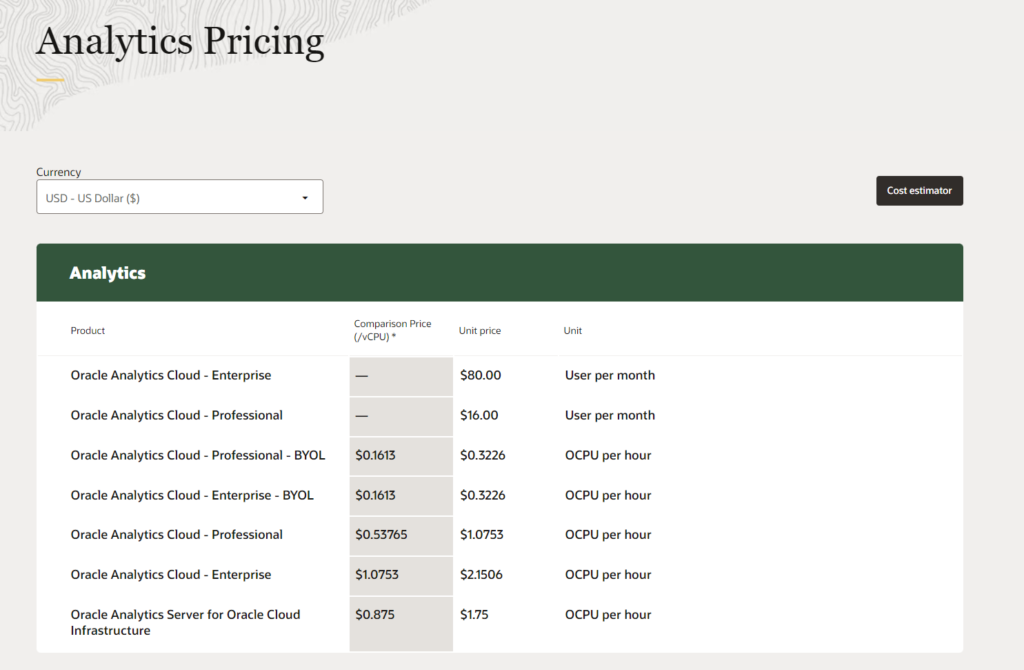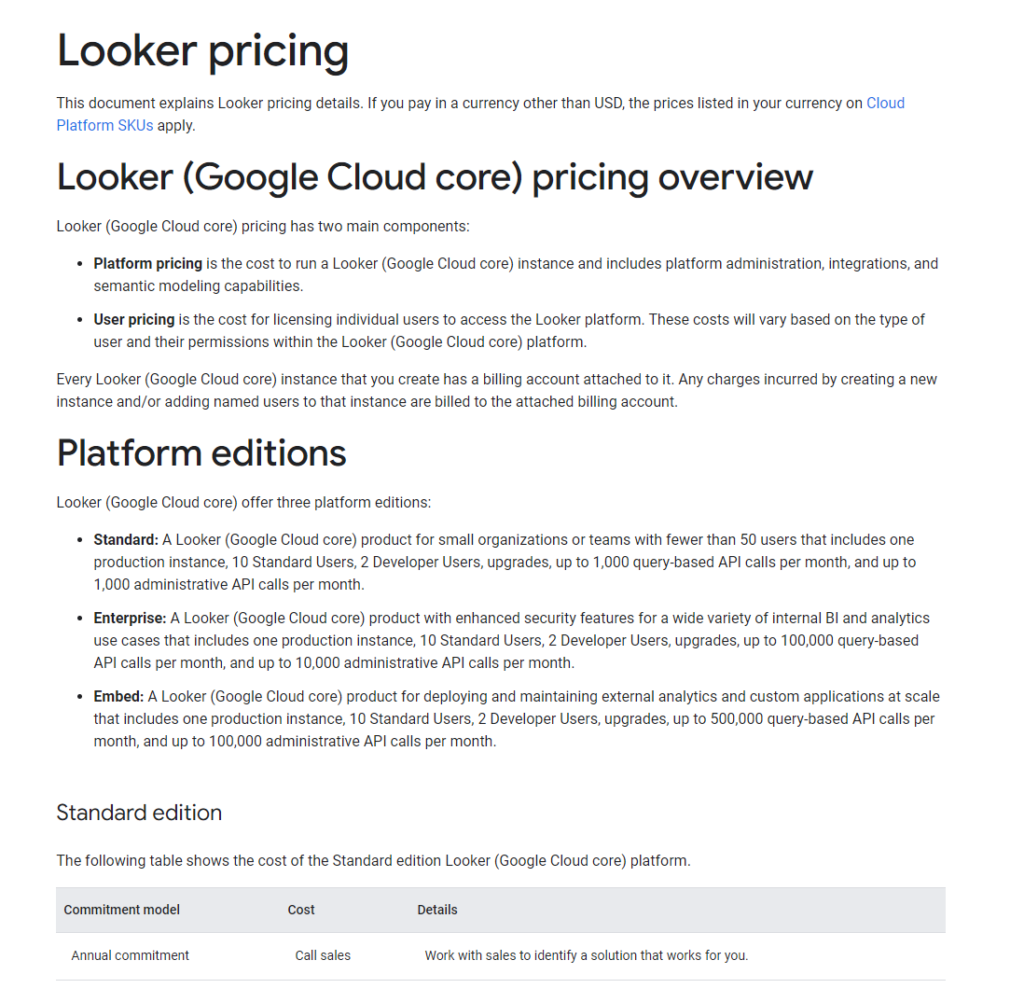In the vast sea of data analytics, choosing the right tool can feel like setting sail without a compass. But fear not, intrepid explorer! Today, we embark on a journey to navigate the waters between two towering lighthouses in the analytics realm: Oracle Analytics Cloud (OAC) and Looker. Each offers unique capabilities and insights, but which is the beacon that will guide your business to the shores of success? Whether you’re a data analyst seeking the treasure trove of insights or a business owner charting a course through the competitive landscape, this guide is your map to discovering the best analytics tool for you. Let’s hoist the sails and dive into the world where data meets decision, and simplicity meets sophistication.
| Oracle Analytics Cloud | Looker |
|---|---|
 | |
| G2 Score -4.0 out of 5 | G2 Score -4.4 out of 5 |
| TrustRadius Score -8.1 out of 10 | TrustRadius Score -8.0 out of 10 |
Area of Comparison: User Interface and Accessibility
In the quest for the best analytics tool, the journey begins at the user interface (UI) – the bridge of our analytics ship. A tool’s UI and accessibility are akin to the ease of navigating through calm or stormy seas. Let’s steer through the UI experiences of Oracle Analytics Cloud and Looker to see which tool will keep your voyage smooth and your crew happy.
Oracle Analytics Cloud: Navigating the Depths
Oracle Analytics Cloud is like a seasoned galleon, equipped with a broad array of instruments and maps for the data-driven journey. Its dashboard is a captain’s quarters filled with advanced tools, detailed charts, and custom reports. The UI is robust, designed to cater to the seasoned sailor of data seas, offering deep dives into analytics with complex capabilities at your fingertips.
For the experienced data analyst, OAC’s comprehensive environment is exhilarating, offering the freedom to explore vast data oceans with precision. However, for newcomers to the world of analytics, the initial encounter with OAC can be daunting – like a deck swabbing recruit facing the helm of a galleon for the first time. The sophistication of OAC’s UI demands a learning curve, but for those willing to climb the crow’s nest, the view is unparalleled.
Looker: Smooth Sailing on Data Lakes
Looker, in contrast, is like a swift schooner designed for agility and ease of navigation. Its UI is intuitive, welcoming sailors of all ranks with open arms. The platform focuses on making data accessible and actionable, with an emphasis on collaboration and sharing insights across teams. Looker’s approachable interface is complemented by its powerful LookML language, allowing for deep customization while maintaining user-friendliness.
The journey with Looker begins with a gentle breeze, guiding users through data exploration with visualizations and dashboards that simplify complex data sets into understandable insights. This tool is crafted for those who appreciate clarity and collaboration, making it a favorite among businesses looking to democratize data across their crew.
Pricing: Oracle Analytics Cloud vs Looker
The price of an analytics tool not only affects the immediate budget but also determines the long-term investment in your data voyage. Let’s navigate through the pricing strategies of OAC and Looker to discover which might offer the treasure of value you seek.
Oracle Analytics Cloud: Charting the Enterprise Waters

Oracle Analytics Cloud, with its robust suite of features designed for comprehensive data analytics, adopts a pricing model that reflects its enterprise-grade capabilities. OAC’s pricing is typically structured around a subscription model, where costs are based on the scale of your usage, including factors like the amount of data processed, the number of users, and the level of computational resources deployed.
This model offers flexibility and can be scalable, but it also means that the journey into understanding and forecasting costs can be as complex as navigating through a dense fog. Businesses interested in OAC need to carefully consider their current and future analytics needs to estimate the investment accurately. For enterprises with the budget and a clear map of their data analytics journey, OAC’s pricing can be seen as an investment in a powerful tool capable of handling expansive data landscapes.
Looker: Navigating the Flexible Seas of Analytics

Looker offers a pricing model that aims to be as transparent and flexible as its platform. Like OAC, Looker’s costs are subscription-based, but they tend to emphasize the number of users and the level of access each user requires. This approach can make Looker an attractive option for organizations of various sizes, from startups dipping their toes into the analytics sea to large enterprises charting complex data courses.
One of Looker’s strengths in its pricing model is the attempt to align costs with value. By focusing on user access and capabilities, companies can scale their investment based on how extensively they use the platform. However, as with any powerful tool, the deeper the usage and the more users onboarded, the higher the investment. Companies considering Looker must weigh their current needs against their growth trajectory to understand how pricing may evolve.
Data Integration and Management: Oracle Analytics Cloud vs Looker
This is the keel of our analytics vessel, the foundational layer that supports and streamlines our voyage through vast data oceans. Both Oracle Analytics Cloud (OAC) and Looker offer powerful capabilities in this realm, but their approaches and efficiencies can be as different as a galleon to a schooner. Let’s navigate through the intricacies of data integration and management capabilities of both platforms.
Oracle Analytics Cloud: The Sturdy Galleon with a Cargo Hold for All
Oracle Analytics Cloud is built for the heavy lifter. It’s equipped to handle a vast array of data types and sources, from traditional databases to modern cloud applications. OAC’s strength lies in its robust data integration tools that can process, cleanse, and harmonize data from disparate sources, preparing it for a unified analytics journey.
One of OAC’s notable capabilities is its ability to integrate not just Oracle’s own data solutions but also external data systems, making it a versatile choice for organizations with complex data ecosystems. Its ETL (Extract, Transform, Load) processes are powerful, designed to manage large volumes of data efficiently, ensuring that the analytics deck is always clear for smooth sailing.
However, the breadth and depth of OAC’s data management capabilities might require a navigator well-versed in data science or IT. The complexity of setting up and managing these integrations can be akin to navigating through a dense fog without a compass for those unfamiliar with the territory.
Looker: Agile Sailing with a Modern Compass
Looker takes a more streamlined approach to data integration and management, emphasizing agility and modern data practices. Instead of heavy lifting on its own, Looker utilizes the power of its hosting databases to process and manage data. This strategy allows Looker to focus on what it does best – providing real-time analytics and insights without the burden of data processing overhead.
With Looker’s approach, businesses can tap into their existing data infrastructure, leveraging LookML – Looker’s modeling language – to define and manage data relationships. This method promotes a centralized data model, ensuring consistency and accessibility of data across the organization. Looker’s model fosters collaboration and ease of use, making it easier for teams to share insights and make data-driven decisions without the need for extensive technical know-how.

Related: Check out our free SEO suite

Scalability and Performance: Oracle Analytics Cloud vs Looker
In the vast ocean of data, the ability of an analytics tool to scale with your growing needs while maintaining top-notch performance is akin to having a reliable compass; it ensures you can navigate future storms without losing your way. Let’s examine how Oracle Analytics Cloud (OAC) and Looker fare when the winds pick up and the data waves grow taller.
Oracle Analytics Cloud: The Sturdy Vessel for Expansive Voyages
Oracle Analytics Cloud is built like a majestic ship designed for the long haul. It’s engineered to handle not just today’s data loads but also the unpredictable expansions of tomorrow. With Oracle’s powerful infrastructure under its sails, OAC offers exceptional scalability, capable of growing with your organization’s data needs, no matter how vast they become.
A key to OAC’s scalability lies in its cloud-native architecture, allowing for elastic scalability. This means resources can be dynamically adjusted based on your analytics demands, ensuring consistent performance even as data volumes and user counts increase. Whether you’re navigating calm seas or facing a tempest of data, OAC maintains its course, providing the speed and agility needed for real-time analytics and insights.
However, harnessing the full power of OAC’s scalability and performance features often requires a knowledgeable crew adept in cloud and data technologies. For organizations with the expertise to manage and optimize these capabilities, OAC is a formidable tool that grows with you, ensuring your data analytics capabilities are never marooned.
Looker: The Swift Clipper Ready to Ride the Data Waves
Looker, with its modern architecture, approaches scalability and performance from a slightly different angle. Designed for the agile movement, Looker relies on the strength of its underlying database to scale. This unique approach means that as long as your database performance is optimized for growth, Looker can handle your increasing data and user demands without breaking a sweat.
This reliance on the database for performance and scalability has its advantages, particularly in terms of flexibility and efficiency. It allows Looker to be database agnostic, fitting seamlessly into your existing data ecosystem and scaling as your database scales. This makes Looker an excellent co-pilot for businesses already invested in powerful, scalable database solutions and looking for an analytics tool that can keep pace with their growth.
The flip side of Looker’s model is that your scalability and performance are as good as your database’s capabilities. This means additional consideration must be given to database management and optimization to ensure Looker can perform at its best as your data grows.
Conclusion
The seas of data analytics are wide and wild, full of potential discoveries and insights that can transform your business. The key to a successful voyage lies not just in choosing the right analytics tool but in how you leverage its capabilities to inform decisions, drive strategy, and navigate the future. Whether you choose Oracle Analytics Cloud or Looker, the true north of your journey should always be the actionable insights that guide your business to new horizons.
READ NEXT:
- MicroStrategy vs Optimizely: The Best Analytics Tool for You
- Oracle Analytics Cloud vs HubSpot Marketing Analytics: The Best Analytics Tool for You
- How to Maximize Your Earnings with Amazon Affiliate Marketing
- Oracle Analytics Cloud vs Optimizely: The Best Analytics Tool for You
- Stripo vs SalesHandy: The Best Email Marketing Tool for You
- 11 Best SMS Marketing Software: Our Picks!
- 11 Marketing Analytics Tools to Elevate Your Data-Driven Strategies
- 29+ Digital Analytics Software to Skyrocket Your Digital ROI




















